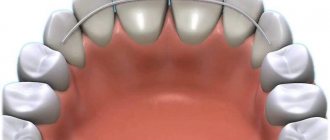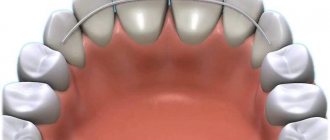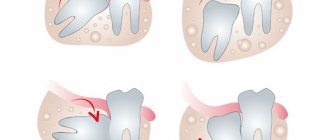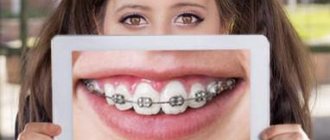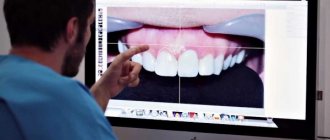10993
Teeth filing technology has been used in dental practice since the beginning of the 19th century. At that time, this procedure was used as a preservative during the treatment of caries.
With the improvement of therapy methods and the expansion of the list of instruments used, this treatment technology was abandoned, however, in some situations, filing is still used.
Indications
There are opposing opinions among dentists regarding the procedure, but there are situations in which filing is necessary:
- When installing crowns. For reliable fixation of the crown, it must fit tightly to the tooth surface.
Since the anatomical shape of each molar or incisor is not ideal, grinding down of the upper layers of their hard tissue is required. This allows you to give your own bone organ the correct geometric shape, thanks to which the manufactured product is firmly fixed and does not stand out among other elements of the jaw row. - For fixing veneers. Ceramic plates fixed to the surface of your own teeth have a certain thickness.
Therefore, in order for the installed microprostheses to fit firmly and not protrude beyond the boundaries of the native units, a small amount of hard tissue is ground off from the vestibular side of the elements of the jaw row. - Preparation for inlays. If it is necessary to mask the cavity formed as a result of carious lesions, ceramic or metal inlays can be used.
Their fixation requires the creation of side walls and the formation of the required depth near the cavity. - In case of installation of an orthodontic structure. Cutting down a small thickness of the top layer of the tooth allows you to make room for correcting the position of the remaining elements of the row without the need to remove them.
In addition, this option is often used in cases of increased crowding of teeth, since it facilitates the placement of fastening elements of the bracket system on them. - If there is damage to the enamel. Chips on the surface of the front incisors can be made less noticeable by slightly filing down the enamel.
This improves the aesthetics of the appearance of the jaw row and eliminates the need for composite restoration. - In case of elongated incisors. If the front teeth are longer than the rest of the row, this can not only cause psychological discomfort, but also interfere with correct diction or complete chewing of food.
To solve the problem, in some cases, filing the length of organs protruding from the common line is used. - At sharp angles. The anatomical structure of the anterior incisors is not always ideal. If there are sharp corners, dentists may recommend filing them down, which will increase the aesthetic appearance of the entire jaw row.
Indications for the use of orthoimplants and tactics for their installation.
Let's discuss here how the braces system works.
At this address https://orto-info.ru/ortodonticheskoe-lechenie/podgotovitelnyiy-period/separatsiya-zubov.html we will talk about abrasive teeth separation.
Why do teeth grow at random?
Malocclusions are often caused by heredity. If parents have certain defects in the dental system, we can guess what dental problems their child will face. However, some systemic diseases, injuries, and improper oral care in childhood also lead to crooked teeth.
The main reasons why adult teeth are positioned incorrectly:
1.Underdevelopment of the dental system
Oddly enough, this is a problem of the accelerated development of civilization and the inability of the human body to adapt so quickly to a new environment. We began to eat freeze-dried food, which does not contribute to the development of the dental system. Genetically, the number of teeth remains the same, but the jaws do not receive the proper load and remain underdeveloped. As a result, teeth grow crowded and become crooked.
2.Premature tooth loss
If a baby tooth is removed before its due date, neighboring teeth tend to take its place, and the dentition is formed incorrectly. Further correction requires considerable time and financial costs. However, the problem concerns not only milk teeth, but also permanent teeth. Injuries sustained in adulthood can cause serious abnormalities. The long-term absence of one or more dental units leads to irreversible consequences: neighboring teeth are displaced, the bite is disrupted.
3. Problematic wisdom teeth
In addition to the fact that the eights themselves can grow crookedly, they contribute to the crowding of the remaining teeth. There is not enough space in the dentition for their full growth; from the moment they erupt, they harm neighboring teeth.
If you are embarrassed about your smile, contact an orthodontist - the problem can be solved.
Contraindications
The necessity and admissibility of filing teeth is determined by the dentist individually in each case, since the procedure is quite labor-intensive and can be traumatic in some situations.
For this reason, sewing hard fabric is contraindicated in the following situations:
- increased abrasion of enamel;
- hyperesthesia;
- bruxism;
- presence of bad habits - frequent chewing of seeds and nuts, opening bottles with teeth;
- high risk of injury to the incisors, for example, boxing and other types of wrestling.
Veneers with minimal grinding of teeth
The thinner the veneer, the less you need to grind off the enamel before installing a microprosthesis. The table below will help you compare the characteristics of different types of structures and choose the best option with the least grinding of teeth and optimal cost.
Composite veneers
Manufacturing type:
Formed immediately in the patient’s oral cavity
Thickness:
0.3 - 0.6 mm
Turning:
No
Price in Moscow:
from 5,000 rub.
- Speed of production.
- Installation without grinding teeth.
- Acceptable price.
- Short service life.
- Variability of color.
- Fragility.
- Insufficient aesthetics.
- Poor ability to hide dental defects.
Ceramic veneers
Manufacturing type:
Produced in a dental laboratory
Thickness:
0.5 mm
Turning:
Yes
Price in Moscow:
from 14,000 rub.
- Aesthetics.
- Reliability.
- Color constancy.
- Durability.
- High price.
- Irreversibility of turning a tooth under a ceramic veneer.
- Long production time.
Zirconium veneers
Manufacturing type:
Produced in a dental laboratory
Thickness:
0.5 - 0.7 mm
Turning:
Yes
Price in Moscow:
from 17,000 rub.
- Aesthetics.
- Durability.
- Strength.
- High price.
Technique
The procedure for filing teeth is carried out in several stages:
- Preparation. At the first meeting, the dentist assesses the condition of the patient’s jawbone elements, determines whether there is a need for cutting down hard tissue and whether there are contraindications to the procedure.
- Identifying problem areas. Using carbon paper, a liquid aerosol or a wax plate, the dentist determines the overestimated areas of the tooth. Areas that require sanding will be colored more intensely.
- Sawing. The filing procedure may vary slightly depending on the goal to be achieved and the shape of the tooth being processed.
So, when treating chewing molars, the dentist carefully grinds off the top layer of enamel from the surface of the tubercles. When cutting down the front incisors, multidirectional movements are carried out.
In some cases, it may be necessary to preliminary make a diagnostic model based on casts of the patient’s jaw rows.
The resulting gypsum sample is subjected to careful inspection and evaluation filing. Carborundum cutters or diamond burs are used as instruments for the operation
The procedure often ends with polishing and remineralization of the treated units. The dentist applies a certain composition containing a complex of useful substances to the enamel to increase the strength of the outer layer of the tooth and reduce permeability .
What is teeth filing
Teeth filing is a procedure aimed at changing their size and shape for one reason or another. Only a doctor can carry it out using special instruments.
There are situations when it is necessary to change the shape or size of dental units.
The procedure is performed before installing veneers, implants, inlays, and dentures. Indications: damage to enamel, excessive length of incisors, sharp corners.
There are two main areas in dentistry:
- Cosmetic filing.
- Sawing for medicinal purposes.
Technically, these procedures are similar to each other, but have their own nuances and different goals.
Cosmetic filing
Many dental clinics offer their patients to get a beautiful smile by filing down defective teeth. The result that can be achieved with this is the following:
- Aesthetic appearance: sharp corners are removed, teeth look neater.
- Filing down minor chips, which helps avoid the need for a complete restoration of the jaw unit.
- Alignment of teeth.
Filing for medicinal purposes
Typically, cutting down teeth for therapeutic purposes is performed before fixing artificial elements, such as crowns or veneers. The top layer of enamel in this case wears off significantly. This procedure in dentistry is called preparation.
The installation of veneers does not always involve preliminary filing of the front surface of the teeth.
In exceptional cases, enamel removal is not required. For example, when the teeth are initially small (microdentia) or when they are naturally worn down.
Dentist
Novikova Olga Alexandrovna
8 years of experience
It is important that any installed artificial element is a large product, and if the teeth are left in their original form, the final structure will be very voluminous. Also, veneers and crowns will not be able to fit harmoniously into the main row.
For veneers, teeth are ground down until the enamel is completely removed. In the case of installing crowns, the dentist makes preparations from all sides so that, as a result, all layers are removed from the tooth, which allows you to avoid possible caries and properly secure the structure. Crown grinding can be painful, which is why it is performed under anesthesia.
For several weeks after filing, a person experiences hypersensitivity of the teeth, but after a few days it goes away.
Increased sensitivity after the procedure
Many patients who have had their teeth filed complain of increased sensitivity, especially when eating hot and cold dishes and hard foods.
Dentists explain this phenomenon as follows. Dentin, located under the enamel, is penetrated by many tubules, inside of which nerve endings are located. As the thickness of the enamel decreases, pressure changes occur, which can cause pain when taking certain foods.
To reduce tooth sensitivity after the procedure, dentists recommend temporarily avoiding too hard foods, dishes with high and low temperatures, and acidic drinks.
During oral hygiene, you should use a brush with soft bristles and therapeutic and prophylactic toothpaste, rinses for sensitive teeth.
If sensitivity does not disappear a week after filing, you should contact your dentist.
Indications and contraindications for orthognathic surgery, recovery time.
In this article we will tell you how to install braces on crowns.
Follow the link https://orto-info.ru/ortodonticheskoe-lechenie/podgotovitelnyiy-period/informativnost-telerentgenogrammyi.html if you are interested in the importance of a teleroentgenogram in orthodontics.
Veneers without grinding – is this possible?
The need to prepare teeth before veneering depends to a greater extent on the indications and to a lesser extent on the type of restoration. Lumineers and their Russian analogue ultraneers have a minimum thickness. Therefore, there is no need for grinding before fixing them to the tooth. However, if the teeth are large and require correction of shape and size, preparation is indispensable. Thus, veneers without grinding can be placed for the following indications:
- Need for minor tooth discoloration.
- Elimination of gaps (diastemas) between the front teeth.
- Masking cracks in tooth enamel.
- The need to restore a chipped cutting edge of a front tooth.
The need to correct the shape of the teeth, add volume to them, as well as visually change the angle of their location or align the cutting edge will in any case require preliminary preparation.
At home
Fear of doctors and thoughts about the pain of professional manipulations often lead to patients trying to cope with the existing problem on their own. Teeth filing is also no exception.
Dentists share their experience that people often come to appointments whose enamel has been severely damaged by attempts to cut off part of it with various improvised tools in the desire to improve the aesthetic appearance of the jaw row with prominent front teeth or the presence of chips.
In addition to the problem of high sensitivity, these patients experience cracks in the hard tissue, as well as dentin damage, which develops as a result of bacteria entering the dentinal tubules through open pores.
The consequence of such independent actions can be the development of caries, pulpitis and numerous complications that can lead to partial or complete tooth destruction.
Dentists categorically prohibit performing teeth filing procedures at home. Only a specialist can determine the need for an operation to remove a section of enamel and carry it out efficiently, without the risk of complications.
How dangerous is crooked teeth in adults?
Now you know what ways there are to correct your bite in adulthood. If you want to transform your appearance, qualified dental orthodontists will help you!
But what happens if bite defects are not corrected? Are crooked teeth so harmless, even if they don't bother you? This is not an idle question, and here's why.
Even if you are not currently concerned about aesthetics, crooked teeth can cause a lot of trouble in the future. First there will be problems with oral hygiene. The accumulation of bacteria and plaque in hard-to-reach interdental spaces will lead to the development of caries, which will be difficult to notice. The process of tissue destruction will deepen, which can lead to pulpitis, the development of an inflammatory process in the roots and, as a result, tooth loss, destruction of bone tissue, impaired diction and facial deformation. And that's not the worst thing. Anomalies of the dental system can cause a number of disorders in the functioning of the masticatory muscles and the temporomandibular joint. As a result, difficulties with chewing food, excessive abrasion of teeth, and disturbances in the gastrointestinal tract. As you can see, crooked teeth can ruin not only a smile, but also affect the health and appearance of an adult.
While some people invent problems for themselves and try to correct even ideal proportions, others do not notice obvious defects and put their health in serious danger.
Don’t put off visiting a qualified orthodontist. A good doctor will assess the actual condition of the patient’s teeth and suggest the most effective way to solve the problems. ←Return to list of articles
Price
The cost of filing teeth depends on the reasons for which it is carried out and what result is needed to achieve:
- preparation for caries - from 200 to 350 rubles per row element;
- treatment of enamel after removing braces – 550-650 rubles;
- identification of traumatic occlusion and grinding of one tooth – 200-300 rubles;
- cutting down a tooth for a crown – 130-200 rubles;
- filing a molar under an orthodontic structure – 150-200 rubles.
Find out how teeth are prepared in the video.
How is turning for veneers carried out?
The reliability of the installation of microprostheses depends on the quality of preparation of the dental surface. Traditionally, the stage of grinding teeth before veneers proceeds as follows. First, the doctor determines the thickness of the enamel layer on the vestibular surface of the teeth that will need to be removed. Next, the dentist makes grooves with a special tool and, focusing on them, grinds down the required amount of dental tissue. In this case, near the gum, the preparation is performed in the form of a grooved ledge. Then the doctor moves on to treating the side surfaces. It can be carried out in two ways: by maintaining the contact points between the teeth or by slightly “grabbing” their lingual surface. The first option is good for preserving the integrity of the dentition, the second has a positive effect on the appearance of future veneers. As for the incisal edge of the teeth, the need for grinding it is directly related to the model of the veneer and the technical requirements for its installation.
Make an appointment
right now!
Mikhailov Andrey Vladimirovich
Surgeon, Orthopedist, Implantologist
How do braces straighten teeth?
Let's start with braces. This is the oldest and most famous method of smile correction. For many children, wearing metal structures at one time became a real psychological trauma, but still, now many of them have straight teeth and an attractive smile. A child’s teeth and bone tissue are much more susceptible to the mechanical effects and directional changes that orthodontic systems provide. For adults, in this regard, everything is more complicated, but this does not mean that they cannot be helped. Today, there are many methods for straightening an adult’s teeth using similar structures. There are metal braces, ceramic braces, clear sapphire braces, etc. They all differ in the material from which the system is made, price, degree of visibility and aesthetics, and the type of placement. For example, vestibular braces are attached to the outside of the teeth, and lingual braces are attached to the inside, therefore they are considered less noticeable. Braces have a number of undeniable advantages. Perhaps the main one is reliability. With a properly qualified orthodontist, properly planned treatment with any brace system will almost certainly bring a positive result. At the same time, there are many nuances.
Where can I straighten my teeth and how long will it take?
It is better to choose a dental clinic for bite correction carefully. Ask your friends and acquaintances if they can recommend where to straighten your teeth. Get acquainted with clinic websites and reviews of doctors’ work. A little research will save you from possible disappointment. An extremely low price should alert you: in such cases, the clinic probably simply does not indicate the cost of additional procedures.
The duration of treatment and price depend on the diagnosis made by the orthodontist. Usually, the doctor can immediately determine exactly in what period it will be possible to straighten the teeth and how much time it will take. Usually, on average, it takes 1.5 – 2 years to straighten teeth with braces. It is impossible to say which braces straighten teeth faster. All braces are effective. Except that with plastic braces, treatment may take longer - they break, and the doctor has to replace parts of the structure, and this delays the treatment time. If you only need to fix one or two teeth and you decide to get veneers, the entire treatment is unlikely to take more than 2 weeks.
There are many ways to straighten your teeth. You just have to decide to change your smile, and after a while you will definitely achieve it. The question of whether teeth need to be straightened should not even arise. Of course you need it! With a beautiful smile, most likely, your attitude towards yourself and the world will change for the better!
In the modern world, teeth straightening is a standard procedure that millions of people of different ages undergo. The fact is that a beautiful smile is not only the key to personal success, but also a means of maintaining health. Some dental abnormalities can cause diseases of various body systems. If you are looking after your health, you should not ignore the presence of dental anomalies. Straightening your teeth and making your smile perfect is not so difficult, and the result will delight you for the rest of your life!
Surgical teeth straightening
Surgery can only correct an abnormal bite, but not straighten the teeth. Surgical intervention is used only in cases where orthodontic treatment is ineffective.
Indications for surgical correction of malocclusion include noticeable skeletal deformities, such as abnormal jaw or chin size.
The operation is performed in a hospital under general anesthesia. Its duration depends on the complexity of the clinical case. After surgery, the patient undergoes a rehabilitation period. He will be able to return to a full life in 3-4 weeks.


